Lissachatina fulica
| East African land snail | |
|---|---|
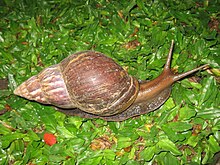
| |
| A live individual of Achatina fulica in Ubud, Bali | |
NE[1]
| |
| Scientific classification | |
| Kingdom: | |
| Phylum: | |
| Class: | |
| (unranked): | clade Heterobranchia
clade Euthyneura |
| Superfamily: | |
| Family: | |
| Subfamily: | |
| Genus: | |
| Subgenus: | |
| Species: | A. fulica
|
| Binomial name | |
| Achatina fulica (Férussac, 1821)
| |
The East African land snail, or giant African land snail, scientific name Achatina fulica,[2] is a species of large, air-breathing land snail, a terrestrial pulmonate gastropod mollusk in the family Achatinidae.
As they develop rapidly and produce large numbers of offspring, this mollusc is now listed as one of the top 100 invasive species in the world.[3] It is a voracious feeder, and recognized as a serious pest organism affecting agriculture, natural ecosystems, commerce, and also human health. Because of these threats, this snail species has been given top national quarantine significance in the United States.[4] In the past, quarantine officials have been able to successfully intercept and eradicate incipient invasions on the mainland USA.[5]
In the wild, this species often harbors the parasitic nematode Angiostrongylus cantonensis, which can cause a very serious meningitis in humans. Human cases of this meningitis usually result from a person having eaten the raw or undercooked snail, but even handling live wild snails of this species can infect a person with the nematode and cause a life-threatening infection.[6]
Subspecies
- Achatina fulica hamillei Petit, 1859[7]
- Achatina fulica rodatzi Dunker, 1852
- Achatina fulica sinistrosa Grateloup, 1840
- Achatina fulica umbilicata Nevill, 1879
Distribution
The species is native to East Africa,[7] but it has been widely introduced to other parts of the world through the pet trade, as a food resource, and by accidental introduction.
This species has been found in China since 1931 (map of distribution in 2007), and its initial point of distribution in China was Xiamen.[8] The snail has also been established in the Pratas Islands, of Taiwan,[9] throughout India, the Pacific, Indian Ocean islands, and the West Indies. In the United States, it has become established in Hawaii[4] and eradication is underway in Florida.[10]
The species has recently been observed in Bhutan (Gyelposhing, Mongar), where it is an invasive species. It has begun to attack agricultural fields and flower gardens. It is believed there that dogs which have consumed the snail died as a result.
A small population has gained a foothold in Dhanbad, within Indian School of Mines campus and in Bangalore, within the Indian Institute of Science campus. The snails were imported as part of crystallographic and NMR studies on Conotoxins.[11] In an act of misguided compassion, the snails were released post-experimentation, and have colonised vast swathes of forested campus grounds. Their escape into the city-proper would be catastrophic for the local ecosystem.
In Paraguay, the first sighting of the African snail was reported in Concepción in 2011. Later cases were reported in different parts of the country in 2012. It is believed that the snail may have been introduced into the country either as fishing bait in Ayolas, or as pets in Ciudad del Este. Other sightings have been reported in urban areas around the capital Asuncion.
Description

The adult snails have a height of around 7 centimetres (2.8 in), and their length can reach 20 centimetres (7.9 in) or more.
The shell has a conical shape, being about twice as high as it is broad. Either clockwise (dextral) or counter-clockwise (sinistral) directions can be observed in the coiling of the shell, although the right-handed (dextral) cone is the more common. Shell colouration is highly variable, and dependent on diet. Typically, brown is the predominant colour and the shell is banded.[12]
 |
 |
 |
Ecology
Habitat
The East African land snail is native to East Africa, and can be traced back to Kenya and Tanzania. It is a highly invasive species, and colonies can be formed from a single gravid individual. In many places, release into the wild is illegal. Nonetheless, the species has established itself in some temperate climates and its habitat now includes most regions of the humid tropics, including many Pacific islands, southern and eastern Asia, and the Caribbean. The giant snail can now be found in agricultural areas, coastland, natural forest, planted forests, riparian zones, scrub/shrublands, urban areas, and wetlands.
Feeding habits

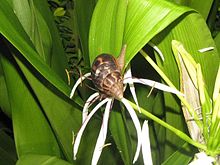
The giant East African snail is a macrophytophagous herbivore; it eats a wide range of plant material, fruit, and vegetables. It will sometimes eat sand, very small stones, bones from carcasses and even concrete as calcium sources for its shell. In rare instances the snails will consume each other.
In captivity, this species can be fed on grain products such as bread, digestive biscuits, and chicken feed. Fruits and vegetables must be washed diligently as the snail is very sensitive to any lingering pesticides[citation needed]. In captivity, snails need cuttlebone or other calcium supplements to aid in the growth and development of their shells. They also enjoy the yeast in beer, which provides protein for growth stimulus[citation needed].
A. fulica requires about 18.28% of crude protein in its diet to achieve optimal growth.[13]
Life cycle


The Giant East African Snail is a simultaneous hermaphrodite; each individual has both testes and ovaries and is capable of producing both sperm and ova. Instances of self fertilization are rare, occurring only in small populations. Although both snails in a mating pair can simultaneously transfer gametes to each other (bilateral mating), this is dependent on the size difference between the partners. Snails of similar size will reproduce in this way. Two snails of differing sizes will mate unilaterally (one way), with the larger individual acting as a female. This is due to the comparative resource investment associated with the different genders[citation needed].
Like other land snails, these have intriguing mating behaviour, including petting their heads and front parts against each other. Courtship can last up to half an hour, and the actual transfer of gametes can last for two hours. Transferred sperm can be stored within the body for up to two years. The number of eggs per clutch averages around 200. A snail may lay 5-6 clutches per year with a hatching viability of about 90%.
Adult size is reached in about six months; after which growth slows but does not ever cease. Life expectancy is commonly five or six years in captivity, but the snails may live for up to ten years. They are active at night and spend the day buried underground.
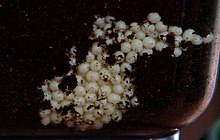 |
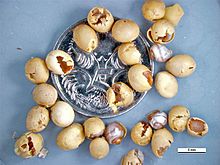 |
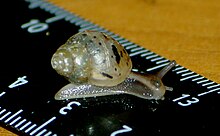 |
The East African Land Snail is capable of aestivating for up to three years in times of extreme drought, sealing itself into its shell by secretion of a calcerous compound that dries on contact with the air. This is impermeable; the snail will not lose any water during this period[citation needed].
Parasites
Parasites of Achatina fulica include:
- Aelurostrongylus abstrusus[14]
- Angiostrongylus cantonensis - causes eosinophilic meningoencephalitis[14]
- Angiostrongylus costaricensis - causes abdominal angiostrongyliasis[14]
- Schistosoma mansoni - causes schistosomiasis, detected in faeces[15]
- Trichuris spp. - detected in faeces[15]
- Hymenolepis spp. - detected in faeces[15]
- Strongyloides spp. - detected in faeces and in mucous secretion[15]
Pest control

In many places the snail is seen as a pest. Suggested preventative measures include strict quarantine to prevent introduction and further spread. Many methods, including hand collecting and use of molluscicides and flame-throwers, have been tried to eradicate the giant snail. Generally, none of them has been effective except where implemented at the first sign of infestation. In Bhutan, the Plant Protection Center used salt to contain the snails, while to reduce snails' food availability, the surrounding weeds were killed using glyphosate[citation needed].
In some regions, an effort has been made to promote use of the Giant East African Snail as a food resource, the collecting of the snails for food being seen as a method of controlling them. However, promoting a pest in this way is a controversial measure, as it may encourage the further deliberate spread of the snails.
One particularly catastrophic attempt to biologically control this species occurred on South Pacific Islands. Colonies of A. fulica were introduced as a food reserve for the American military during the second world war and they escaped. A carnivorous species (Florida rosy wolfsnail, Euglandina rosea) was later introduced by American government, but it instead heavily harvested the native Partula, causing the loss of most Partula species within a decade.
Human use
Achatina fulica are used by some practitioners of Candomblé for religious purposes in Brazil as an offering to the deity Oxalá. The snails substitute for a closely related species, the African Giant Snail (Archachatina marginata) normally offered in Nigeria. The two species share a common name (Ìgbín, also known as Ibi or Boi-de-Oxalá in Brazil), and are similar enough in appearance to satisfy religious authorities.[16] They are also edible if cooked properly.
References
This article incorporates CC-BY-2.0 text from the reference.[16]
- ^ IUCN 2009. IUCN Red List of Threatened Species. Version 2009.1. <www.iucnredlist.org>. Downloaded on 10 July 2009.
- ^ "Achatina fulica". Integrated Taxonomic Information System. Retrieved July 6, 2007.
- ^ Global Invasive Species Database: 100 of the Worst Invasive Species
- ^ a b Cowie R. H., Dillon R. T., Robinson D. G. & Smith J. W. (2009). "Alien non-marine snails and slugs of priority quarantine importance in the United States: A preliminary risk assessment". American Malacological Bulletin 27: 113-132. PDF
- ^ PBS "Alien Invasion". Accessed on 6 January 2008
- ^ African snail: Deadly invasion in South America
- ^ a b Attention: This template ({{cite doi}}) is deprecated. To cite the publication identified by doi:10.3897/zookeys.70.762, please use {{cite journal}} (if it was published in a bona fide academic journal, otherwise {{cite report}} with
|doi=10.3897/zookeys.70.762instead. - ^ Attention: This template ({{cite doi}}) is deprecated. To cite the publication identified by doi:10.1371/journal.pntd.0000368, please use {{cite journal}} (if it was published in a bona fide academic journal, otherwise {{cite report}} with
|doi=10.1371/journal.pntd.0000368instead. figure 5. - ^ Wu S.-P., Hwang C.-C., Huang H.-M., Chang H.-W., Lin Y.-S. & Lee P.-F. (2007). "Land Molluscan Fauna of the Dongsha Island with Twenty New Recorded Species". Taiwania 52(2): 145-151. PDF.
- ^ Campo-Flores, Arian. October 4th, 2011. "Giant Alien Snails Attack Miami, Though They're Not in Much of a Rush: Eradication Teams Go House to House, Nabbing 10,000 Invaders; 'Crunch Under Our Feet'." Wall Street Journal. Link
- ^ http://www.sciencedirect.com/science/article/pii/S0014579303010160
- ^ Skelley, PE; Dixon, WN; and Hodges, G. 2011. Giant African land snail and giant South American snails: field recognition. Florida Department of Agriculture and Consumer Services. Gainesville, Florida. PDF
- ^ Template:Pt icon Soares C. M., Hayashi C., Gonçalves G. S., Nagae M. Y. & Boscolo W. R. (1999). "Exigência de proteína para o caracol gigante (Achatina fulica) em fase de crescimento. Protein requirements for giant snail (Achatina fulica) during the growth phase". Acta Scientiarum. Animal Sciences 21(3): 683-686. abstract, PDF.
- ^ a b c Attention: This template ({{cite doi}}) is deprecated. To cite the publication identified by doi:10.1590/S0036-46652010000400009, please use {{cite journal}} (if it was published in a bona fide academic journal, otherwise {{cite report}} with
|doi=10.1590/S0036-46652010000400009instead. PDF. - ^ a b c d Template:Sp icon Libora M., Morales G., Carmen S., Isbelia S. & Luz A. P. (2010). "Primer hallazgo en Venezuela de huevos de Schistosoma mansoni y de otros helmintos de interés en salud pública, presentes en heces y secreción mucosa del molusco terrestre Achatina fulica (Bowdich, 1822). [First finding in Venezuela of Schistosoma mansoni eggs and other helminths of interest in public health found in faeces and mucous secretion of the mollusc Achatina fulica (Bowdich, 1822)]. Zootecnia Tropical 28: 383-394. PDF.
- ^ a b Attention: This template ({{cite doi}}) is deprecated. To cite the publication identified by doi:10.1186/1746-4269-5-23, please use {{cite journal}} (if it was published in a bona fide academic journal, otherwise {{cite report}} with
|doi=10.1186/1746-4269-5-23instead.
External links
- Mead, Albert R. 1961. The Giant African Snail: A Problem in Economic Malacology. Univ. Chicago Press, 257 pp. (also available online)
- Global Invasive Species Database
- Achatina fulica references from the Hawaiian Ecosystems at Risk project (HEAR)
- Achatina fulica in Captivity
- Slow-moving fast food
- Species Profile- Giant African Snail (Achatina fulica), National Invasive Species Information Center, United States National Agricultural Library. Lists general information and resources for Giant African Snail.
- Template:Cite PMID
- kerosene to combat african snails in kerala
- USDA New Pest Response Guidelines for Achatina fulica PDF

